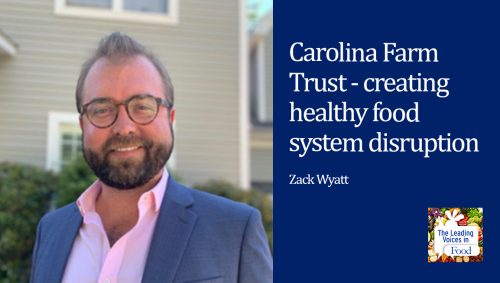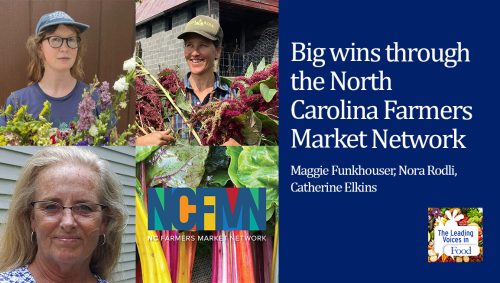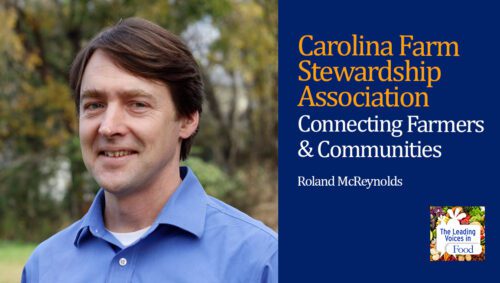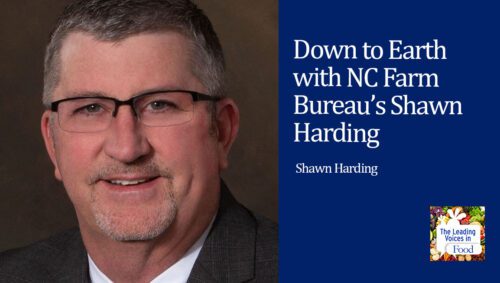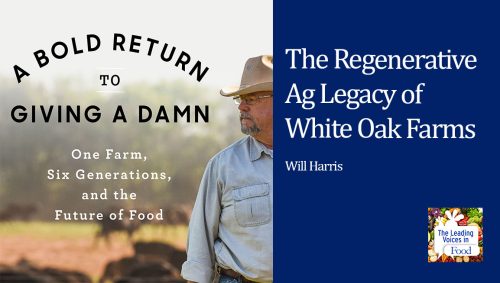The Leading Voices in Food
E47: Hickory Nut Gap Farm’s Jamie Ager on Regenerative Grazing
Jamie and Amy Ager, and their extended family, co-own the Hickory Nut Gap Farm business, and the brand Hickory Nut Gap Meats. Both are graduates of Warren Wilson College, and the couple took over running the farm in 2006 with a vision to achieve environmental sustainability through regenerative grazing. What began as a dream is now a thriving business built on relationships, environmental stewardship, and no small amount of courage.
Subscribe: Apple Podcasts | TuneIN | Google Podcasts | SoundCloud | PocketCasts | Radio Public
Tags: Agriculture & Tech | North Carolina | Regenerative Agriculture | Voice of Farming |

Jamie and Amy Ager, and their extended family, co-own the Hickory Nut Gap Farm business, and the brand Hickory Nut Gap Meats. Both are graduates of Warren Wilson College, and the couple took over running the farm in 2006 with a vision to achieve environmental sustainability through regenerative grazing.
Welcome to The Leading Voices in Food Podcast, an educational series produced by the World Food Policy Center at Duke University. I’m Deborah Hill. You’re listening to a segment in our Voice of Farming series.
Hickory Nut Gap Farm is nestled in Buncombe County in the Blue Ridge Mountains of North Carolina. The farm lies on what was once a through road for drovers taking their animals to the markets in the foothills. The farm itself began in 1916 when Jim and Elizabeth McClure settled here after their honeymoon. And 102 years later, their descendants continued to be stewards of the land.
In the early morning hours at the Hickory Nut Gap Farm store, a rustic converted farm building in Fairview, North Carolina, meat cutters and culinary craftsmen turnout bratwurst, Italian sausage, blueberry breakfast sausage, and more to fill the deli display. Banks of freezers display an astonishing variety of cuts of pasture-raised beef, pork and chicken. The store itself is a story of relationships and partnerships, and it’s a testament to the way Jamie and Amy Agar now run the family business.
Couples and young families come to stock up on meats, and also to enjoy a day in the country. Some order lunch and coffee in the cafe area, introduce their young children to farm animals, and explore the open barns. The store features local products, ranging from North Carolina wine and cheese, to locally made jewelry, soaps, books and jams.
Jamie and Amy Ager, and their extended family, co-own the Hickory Nut Gap Farm business, and the brand Hickory Nut Gap Meats. Both are graduates of Warren Wilson College, and the couple took over running the farm in 2006 with a vision to achieve environmental sustainability through regenerative grazing. What began as a dream is now a thriving business built on relationships, environmental stewardship, and no small amount of courage.
We have Hickory Nut Gap Farm and that’s my family farm out in Fairview, North Carolina. Then we have Hickory Nut Gap Meats, which is a separate company that is an aggregator of pasture-based livestock for the market. Then we have a holding company that just kind of manages the business behind the scenes for both companies. And so, that’s essentially our structure.
And our staff, currently, we have, in the meat side of the business, we have a director of operations, a director of sales, a director of marketing, and we have a director of finance. As well as myself, and I’m sort of CEO, COO. And then my wife, Amy who, we’ve been doing this together for 19 years, is an advisor and a participant in a intimate way with all pieces of the business.
And so, that’s essentially our executive staff. Then we have a warehouse team that consists of four to five people, managing inventory as it comes in from the meat processing plant from that side. And then the other piece of our executive team is Sam Dobson, which is on the supply chain side. And Sam manages all the farmer relationships, as well as runs the organic dairy farm in Iredell County. And so, that’s essentially the team on the wholesale side of the company.
On the farm side, we have a general manager of our little farm store out in Fairview, which is a little retail shop that does quite a bit of deli. We have a butcher case. You can come out there, we’re open seven days a week, most of the year. People come out, enjoy lunch, learn about agriculture. We have some baby chicks, and some piglets, and things like that for folks to see. Then I also just recently hired Asher Wright, who’s our farm manager at the farm there.
And our farm in Fairview, we really want to be sort of understanding of how we can be a farm where people can come touch and feel agriculture, but also be a working farm that’s raising pasture-raised hogs, raising certified organic grass-fed beef, and that type of thing.
My family’s been involved in agriculture for over a hundred years. I grew up farming and really interested in the whole dynamic of land, and farming, and animals, and how it all works together. And so, whenever I came back to the farm and Fairview here in Western North Carolina.
I had a degree in environmental studies with a concentration in sustainable agriculture, and had been introduced to a lot of the concepts like rotational grazing, and pasture management, and also the market opportunity for antibiotic free pasture-based agricultural systems. And so, we started direct marketing off the farm back in 2000. And then I ended up taking an Ag Leadership class through NC State back in 2006. It was the College of Ag and Life Sciences, Ag Leadership Development Program run by Dr. Collins. And in that program, I learned a lot about where we sit in a business sense from an agricultural standpoint in the agriculture industry.
In addition to that, I met a great farmer in Iredell County, North Carolina. Sam Dobson. We quickly became good friends. Being a family farm 20 minutes from downtown Asheville, North Carolina, was kind of the perfect storm to develop a market for these systems.
Basically, Sam and I teamed up and just started to pay attention to supply. From a customer standpoint, the important customers that are out there, our Earth Fare and Whole Foods, and those type folks, that were looking for local beef and pork. And so, we just slowly but surely built the supply chain out from there. Really, I’m a relationships person. I enjoy getting to know farmers and paying attention to systems and making sure it all works right.
You know, over time, it just kind of kept growing, and growing, and growing. At this point, we do have a larger organization that is very entrepreneurial. It feels a lot like a startup still. I call it a 19-year-old startup, but that’s kind of what it’s been the whole time. It speaks to the challenge of the agriculture industry in just how scaled everything is at this point, how difficult to bring product to market is, the supply chain pieces are. There’re so many big, daunting tasks to change the food system, which is essentially the business we’ve ended up in.
Jamie is a leader in the grass-fed beef movement, also called regenerative agriculture, a holistic approach to raising grazing animals that benefits the environment, the animals themselves, and produces healthier meat to eat. It’s a business model in sharp contrast with conventional beef production methods criticized for greenhouse gas production. And it challenges the idea that low cost meat is what we should value over anything else.
Grass-fed beef is a real different production paradigm because it’s not built on the industry model, which is essentially been driving efficiency for the past 80 years. Efficiency was the only real winner in agriculture because the consumer out there was only willing to purchase the cheapest product.
With grass-fed beef, what we’re doing is really focusing on the interaction between cows, or herbivores in general, whether that’s sheep, cows, whatever grazing livestock we’re talking about, and they’ve taken that grazing animal and paying attention to grazing management to a level where there’s now science behind it that shows that we’re sequestering a lot of carbon in the soils through good grazing management. So to me, there’s a paradigm out there that says that beef is not good for the environment. Well, we’ve got a production model here that sequesters carbon through good grazing management that utilizes the animal’s manure and tendency to trample grasses that ultimately builds carbon in the soils by building organic matter.
And so, to me that’s a really big shift from the narrative out there. At the end of the day, there’s more and more folks looking for climate solutions in agriculture. And for me, I was, as a young man, pretty frustrated by the paradigm that the environmental movement had, which was essentially people that are on the land, land managers, farmers, loggers, those types, are bad and they need to be regulated. That’s essentially the paradigm that we ended up with from an environmental standpoint.
But I grew up on a farm… What happens in that paradigm, to me as somebody that grew up on a farm and sees it every day, is you end up with city lawyers making decisions about how farmers should be farming their land. And that disconnect is never helpful. To me, if we can build a company that really is focused on a solutions-oriented model, where we do pay attention to the environment.
We don’t pretend like we have all the answers, but we’re earnest in our effort to try to make things better. And we are, ultimately, on a journey with consumers, and paying attention to organizations like the Savory Institute, or NRCS, that are doing interesting things that help the environment build biodiversity. Create a real synergy between agriculture and the environment. To me, that is what we all need to be paying attention to. At the end of the day, a market-based solution is going to be a real driver of the innovation that’s required. And so, in big round numbers, that’s my thought process.
But in the short term, why it’s more expensive is it’s a decentralized model. You’re putting animals back on pasture, which is not as efficient as having them all concentrated in one place where it’s easy to load them out. It’s also a small industry. So, the processing efficiencies that we have versus the larger packers is just a massive difference in scale. The segregation required, it all carries costs once that animal is killed and put on a rail. The inefficiencies from that point forward, I would say, are the majority of the cost driver in the supply chain.
We’re essentially in the de-manufacturing business. We take one item, like a pig or a cow, and we’ve turned that into 50 items. We have to go to the market with all 50 items in an even based utilization of that whole carcass, effectively. So basically, that’s the real challenge, is how do we do that effectively on a consistent basis in a low-margin industry? And paying farmers quite a bit more so, we can’t dump any product in the commodity chains supply to build a company that has a consistent supply chain in agriculture.
Your supply chain isn’t just sort of a factory-based model. It really is relationships. To us, that is something we’ve put a lot of time and energy, and invested in. Especially in this pasture-based model, where it’s not just sort of a low cost, highly efficient paradigm like the bigger confined animal feeding operations are. And so, our production models are still developing. We don’t have one set way that we’re supplying this stuff. It’s a learning curve on everybody’s side.
That supply chain takes a lot of relationships and a lot of focus as we develop that out. Then, in addition to that, we’re paying farmers significantly more in commodity prices.
Yeah, it’s a lonely place to be in this paradigm shifting model, from an entrepreneurial sense, because there’s very few models out there to follow. And so, we end up in situations where you start handling a lot of meat, and it gets expensive, and you build a lot of inventory. There’s just no other businesses out there to follow. We end up having to wing it to some degree. That can feel scary. I’d say that’s the biggest cantankerous challenge, is really just being…
Everybody says this industry is ripe for growth. I firmly believe that we’re in a good place long-term. But the day-to-day, week-to-week challenges of cashflow and business management can kind of make it hard.
As somebody that’s been in direct marketing business for a long time, I know that business well. It’s an okay model if you want to sell at local tailgate markets and be a participant in the sort of hyper-local part of this movement. But I think that what this movement really needs is brands that they can sell into that are going to continue to scale the industry. And so, the markets is ripening. We feel like we’re in an exciting place and we really want to see these changes in the long-term from a future-oriented standpoint.
I think that the only constant is change. Really paying attention to models that are going to be impactful is part of the job of an entrepreneur. At the end of the day, all farmers are entrepreneurs.
One of the biggest challenges we have as farmers is that we, even the really big ones, we’re all pretty small businesses when it comes down to it. And so to me, agriculture has suffered from that paradigm to some degree because we’re not very well organized. We all end up fighting with each other over land or market share or whatever. That’s just the inevitable result of a bunch of small folks that are making it work, sort of scrapping along, like we all do as farmers. And so, just continue to find ways to build partnerships and bridges and move the industry forward.

